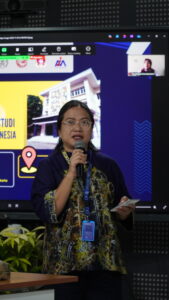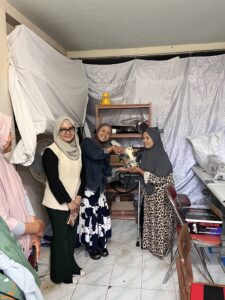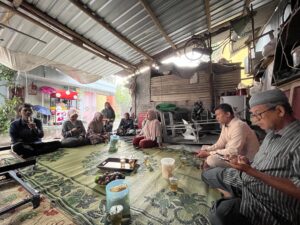Conversations with One Kilometer Residents
Around the ISI Yogyakarta Campus.
 Comics, cergam, or graphic novels can be a space to tell various stories, fiction and non-fiction. They can tell stories of history, origins, and everyday events. This time, in the art project of the stories of the residents of one kilometer around the ISI Yogyakarta campus, these media are played as, say, a space for conversation.
Comics, cergam, or graphic novels can be a space to tell various stories, fiction and non-fiction. They can tell stories of history, origins, and everyday events. This time, in the art project of the stories of the residents of one kilometer around the ISI Yogyakarta campus, these media are played as, say, a space for conversation.
Conversations with several residents around the ISI campus were held from September to November 2011. The conversation was initiated in the Seminar course, DKV ISI Yogyakarta. The conversation was secretly born out of dissatisfaction in various ways. First, residents around the campus are not anonymous residents, but neighbors.
Secondly, these neighbors indirectly become partners of ISI Yogyakarta. They are the ones who on the other hand facilitate the daily survival of students (boarding houses, places to eat, shops, etc.). Conversely, the relationship is not limited to the economic dimension. The relationship can be stretched to a relationship of participation.
Third, so far it is rare to find (or maybe there is no) media that conveys the perception of residents around the ISI Yogyakarta campus about this campus. This needs to be done. It needs to be done when the ISI campus and the surrounding residents both see themselves as neighbors. Like neighbors, they know each other. Because each other knows each other, the prejudices that have been there can at least be overcome.
Fourth, the DIKTI accreditation variable has always been (and still is) an internal variable of the institution. Neighborhood life, or relationships with local residents, are not/not yet accreditation variables. This shows that at the education center level, the bureaucracy still suffers from the dominance of structure over agency. The dominance of this structure is carried over to the variables of institutions in the lower/regional level, say, LPM (Community Service Institution). So, the center and the lower/region are the same: feeling comfortable with the accreditation variables that have been there so far.
Fifth, through conversations with residents, we get to know what is in their minds about the existence of the ISI Yogyakarta campus. This is the reason why the stories of the residents are sought, heard, written, and drawn, and this time exhibited to the residents.
The forty-five stories of the residents range from economic issues, tattoos, dreadlocked muadzin, land (acquisition), to who knows what to say. Economic motives are obvious, but they require a certain way of understanding. Economics is not limited to calculations, it also involves hope and participation. On the other hand, not all the stories described are strong in narration. There is a difference between the written result of conversation and the result of depiction (comics, for example). Some comics still think of themselves as a medium for jokes. Comics should be able to depict something serious! Comics, as a medium for talking, are equipped with various elements: speech bubbles, pictures, writing, emoticons, etc. These elements have not been used to their full potential. These elements are not used to their full potential, or the relationship between content, speech bubbles and gestures is still repetitive.
Beyond comics, cergam and graphic novels, this exhibition includes family photos. This photo is one of the other projects in the stories of the residents. The reason is simple, perhaps family photos are not yet considered important, or perhaps residents consider them important but just haven't had the opportunity. The photos were taken in their homes, in everyday situations. The photos collected were not as many as the titles of the community stories. One reason was that some residents already had family photos. Another reason is that people are reluctant.
This reluctance is one of the problems in being a neighbor. Through this exhibition, hopefully that reluctance will disappear and each other will open up. Perhaps that is where the concept of an art project lies: it is in between, not limited to here, or there. Greetings. (Koskow, May 2012)
A. Exhibition Opening
The exhibition will be held on:
Day, date: Sunday, May 20, 2012
Time: 7:00 PM
Venue: Geneng Elementary School Building (Elementary school classroom)
Remarks: Andres Busrianto (Elementary Classroom Coordinator)
Imam Zakaria (Student Representative of DKV ISI Yogjakarta)
Enlivened by : Village Arts of Geneng Hamlet community
Opened by: Mr. Kerto Rejo (Dukuh Ds. Geneng)
B. Exhibition Event Details
May 20 - 29, 2012, at Geneng Elementary School Building (Elementary School classrooms)
- Monday, May 21, 2012
RESIDENCY PRESENTATION
Speaker: Sudjud Dartanto
Moderator: Justian Jafin Rocx W
Time: 10:00 a.m.
Venue: Plasa FSR ISI Yogjakarta
- Sunday, May 27, 2012
COMIC WORKSHOP
Organizer: Community Design Comic Club (DISKO) DKV ISI Yogjakarta
Time: 09.00 - 12.00 WIB
- Saturday, May 26 - Sunday, May 27, 2012
SOCIAL EVENTS " Geneng Hamlet Family Photo "
Time: 10.00 - finish
Photo organizer by Titik Api Photo Community DKV ISI Yogyakarta.
- Sunday, May 27, 2012
"Campus to Village" DISCUSSION
Speaker:
1. Dr.Suastiwi Triatmidjo, M.Des (Dean of FSR ISI)
2. Mr. Kerto Rejo (Dukuh Ds Geneng)
3. Arief Budiman (ISI student)
Moderator: Rain Rosidi
Time: 14.00 - 16.00 Wib
Venue: Elementary School Classroom
- Tuesday, May 29, 2012
"NGANGKRING COMIC TODAY" DISCUSSION
Speaker:
1. Nano Warsono
2. Mohammad Hadid
Moderator: Justian Jafin Rocx W
Time: 14.00 - finish
Venue: Plasa FSR ISI Yogjakarta






